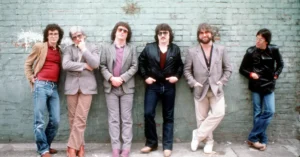Led Zeppelin: Titans of Rock and Architects of Heavy Sound
Led Zeppelin. A Monumental Beginning (1968–1969)
Led Zeppelin was formed in London in 1968, emerging from the ashes of The Yardbirds. When guitarist Jimmy Page needed to fulfill tour commitments after the Yardbirds disbanded, he recruited:
- Robert Plant – vocals
- John Paul Jones – bass and keyboards
- John Bonham – drums
Initially dubbed The New Yardbirds, they soon adopted the name Led Zeppelin, supposedly suggested by The Who’s drummer Keith Moon as a sarcastic jab (“go down like a lead balloon”). Dropping the “a” in “lead” for pronunciation clarity, Led Zeppelin was born — and within a year, the music world would never be the same.
Led Zeppelin. Blazing Trails: The First Albums (1969–1971)
Led Zeppelin (1969)
Their debut album was a seismic shock. It merged blues, hard rock, folk, and psychedelia. With tracks like “Dazed and Confused,” “Good Times Bad Times,” and “Communication Breakdown,” the band redefined how heavy blues-rock could sound — tight, loud, and virtuosic.
Led Zeppelin II (1969)
Their second album pushed the boundaries further. “Whole Lotta Love” became their first hit single, driven by a now-iconic riff. The album is widely considered one of the first true heavy metal records, though Led Zeppelin themselves rejected genre labels.
Led Zeppelin III (1970)
In contrast, their third album leaned heavily into folk and acoustic textures — “That’s the Way” and “Bron-Y-Aur Stomp” revealed a pastoral, British folk side. While initially divisive, the album is now seen as a bold, rich work that showcased the band’s versatility.
Stairway to Immortality: The Peak Years (1971–1975)
Led Zeppelin IV (1971)
Often called “Untitled” or “Four Symbols”, this is arguably the band’s most famous album. It includes “Black Dog,” “Rock and Roll,” and the timeless epic “Stairway to Heaven.” It became one of the best-selling albums in history, with no title or band name on the cover — just mysterious symbols representing each member.
Houses of the Holy (1973)
Expanding into funk, reggae, and prog influences, this album offered “Dancing Days,” “The Ocean,” and the lush “No Quarter.” The experimentation continued without losing their identity.
Physical Graffiti (1975)
A double album filled with both new and older unreleased tracks, Physical Graffiti is hailed as a masterpiece. Songs like “Kashmir,” “Ten Years Gone,” and “Trampled Under Foot” capture the band at their most ambitious.
Led Zeppelin. The Shadow and the Decline (1976–1980)
Presence (1976)
Recorded in haste as Plant recovered from a car crash, Presence is stripped-down and guitar-heavy. It includes the colossal “Achilles Last Stand,” but overall received mixed reviews.
In Through the Out Door (1979)
Led by John Paul Jones and Robert Plant during Page and Bonham’s drug-affected periods, this album included the synth-driven “In the Evening” and the ballad “All My Love.” It showed a softer, more experimental side — but internal tensions were rising.
The End of an Era
On September 25, 1980, John Bonham died after heavy drinking. Rather than replace him, the band officially disbanded in December 1980, releasing a statement that they could not continue as Led Zeppelin without him.
Post-Breakup Projects and Reunions
All members pursued individual careers:
- Jimmy Page worked with The Firm, Roy Harper, and on soundtracks.
- Robert Plant had a successful solo career exploring multiple genres.
- John Paul Jones remained active as a producer and composer.
- Page and Plant reunited in the 1990s for live tours and an album.
In 2007, the band reunited for a one-off show at the O2 Arena in London, with Jason Bonham (John’s son) on drums. It was hailed as a triumphant return, immortalized in the Celebration Day release (2012).
Musical Style and Innovation
Led Zeppelin refused to be boxed into one genre. They combined:
- Blues (reimagined and electrified)
- Hard rock and proto-metal (with riff-heavy tracks)
- British and American folk traditions
- Middle Eastern and world influences
- Studio experimentation and dynamic live improvisation
Jimmy Page’s production techniques, Plant’s vocal power and mystique, Jones’s multi-instrumental genius, and Bonham’s thunderous drumming created a sound unlike any other.
Discography (Studio Albums)
- Led Zeppelin (1969)
- Led Zeppelin II (1969)
- Led Zeppelin III (1970)
- Led Zeppelin IV (1971)
- Houses of the Holy (1973)
- Physical Graffiti (1975)
- Presence (1976)
- In Through the Out Door (1979)
- Coda (1982, posthumous)
Influence and Legacy
- Credited as founders of hard rock and heavy metal, though their influence extends to grunge, doom, alternative, and world music.
- Their albums sold over 300 million copies worldwide.
- Cited as a major influence by countless bands: Black Sabbath, Queen, Rush, Pearl Jam, Tool, and many more.
- Known for revolutionizing live performance, with extended improvisation and unmatched energy.
- Inducted into the Rock and Roll Hall of Fame in 1995.
- Their “Stairway to Heaven” is consistently voted as one of the greatest rock songs of all time.
Interesting Facts
- Jimmy Page was a highly respected session guitarist before Zeppelin, appearing on recordings by The Who, The Kinks, and Donovan.
- The four symbols on Led Zeppelin IV each represent one member — and their meanings are still debated.
- The band rarely released singles in the UK, preferring fans to experience full albums.
- Page’s use of a violin bow on guitar (notably on “Dazed and Confused”) became legendary.
- They never officially reunited as a recording band after 1980, preserving the sanctity of their original run.

Final Thoughts
Led Zeppelin remains one of the most influential and mythic bands in rock history. Their eight-year run reshaped what rock music could be — loud yet intricate, ancient yet modern, savage yet beautiful. Their music continues to inspire generations of musicians and fans, standing not just as songs, but as monuments of sound.






